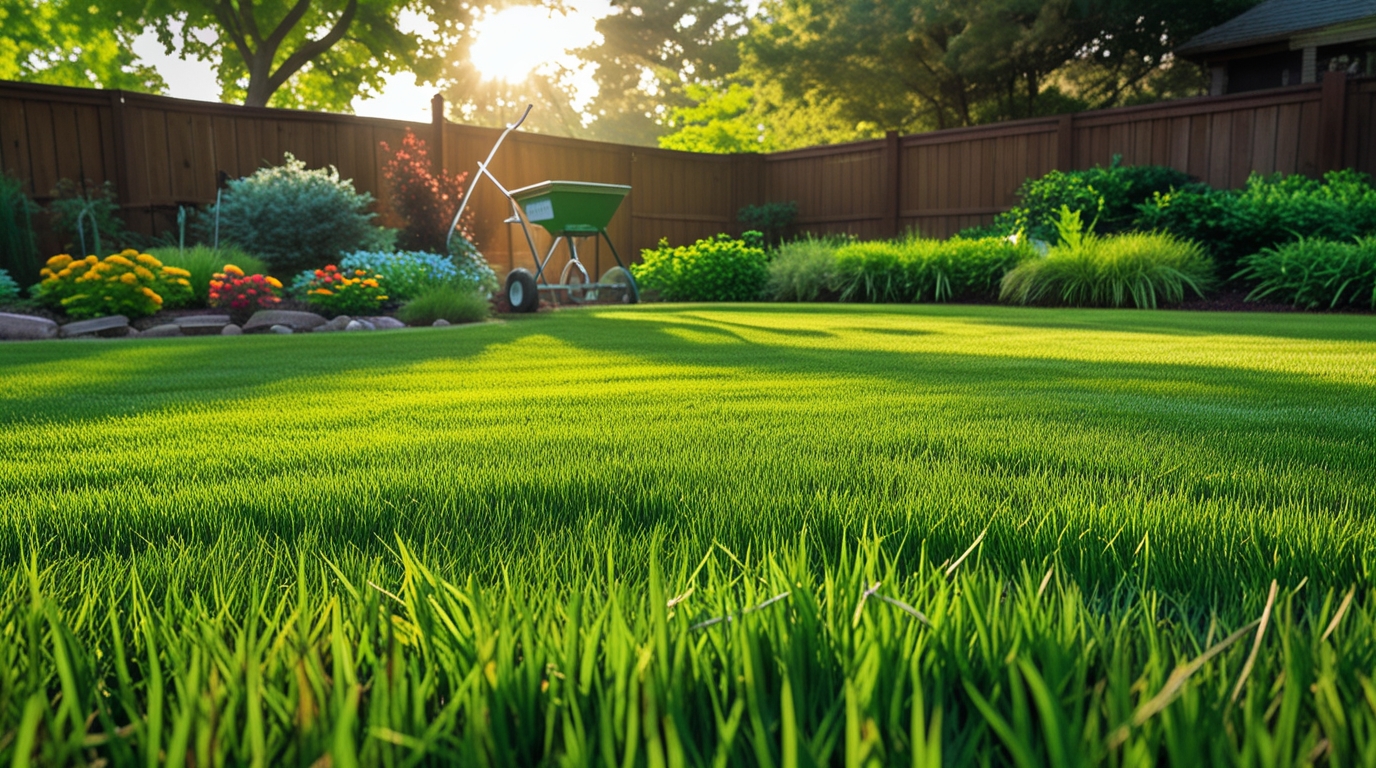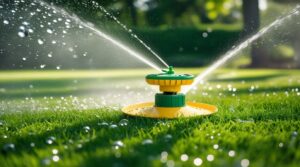Bermuda grass is one of the most popular choices for lush, sun-loving lawns — but it’s also a turf that demands a little extra attention when it comes to fertilization. Unlike some grasses that can get by with minimal care, Bermuda thrives only when it’s fed properly, at the right times, and with the right nutrients.
In fact, studies show that proper fertilization can improve Bermuda lawn density by up to 40%, making it not just greener but also stronger and more resilient against weeds, drought, and foot traffic. Timing and product choice are absolutely crucial if you want that thick, carpet-like lawn you dream of.
In this guide, we’ll walk you through everything you need to know — from picking the best lawn fertilizer for Bermuda to creating a simple, effective feeding schedule. You’ll learn which products are worth investing in, when exactly to apply them during the growing season, and what common mistakes to avoid along the way.
Why Bermuda Grass Needs Specialized Fertilization
Bermuda grass isn’t your average turf — it’s a warm-season powerhouse that grows fast, thick, and vibrant when fed properly. But to keep it looking like a lush green carpet, Bermuda requires a little more love than some other grass types.
One of the biggest reasons Bermuda grass needs specialized fertilization is its high nitrogen demand. Nitrogen fuels the rapid blade growth and deep green color that Bermuda is famous for. Without enough nitrogen, Bermuda lawns can quickly become thin, pale, and vulnerable to weeds.
Because of its fast growth rate, Bermuda also needs more frequent feedings compared to cool-season grasses. Skipping applications or using the wrong product can leave your lawn patchy and underperforming, just when you want it to look its best.
Another reason to get fertilization right? Proper nutrition boosts Bermuda’s natural resilience. A well-fed Bermuda lawn can withstand intense summer heat, drought stress, heavy foot traffic, and even mild pest pressure better than a neglected one.
Finding the best lawn fertilizer for Bermuda ensures you’re giving your grass exactly what it needs to thrive in tough conditions and keep that thick, beautiful appearance year-round.
Up next, let’s look at what to consider when choosing the perfect fertilizer for your Bermuda grass!
Key Factors to Consider When Choosing the Best Fertilizer for Bermuda
Picking the right fertilizer isn’t just about grabbing the first bag you see at the store — it’s about matching your lawn’s needs with the right nutrients and application style. To find the best lawn fertilizer for Bermuda, here’s what you should look for:
Understanding N-P-K Ratios
Every fertilizer bag lists three numbers — like 16-4-8 — representing Nitrogen (N), Phosphorus (P), and Potassium (K).
- Nitrogen fuels lush green blade growth (Bermuda’s favorite).
- Phosphorus supports strong root development.
- Potassium strengthens the grass to resist stress from heat, drought, and pests.
For Bermuda grass, a nitrogen-heavy blend (like 16-4-8 or 30-0-4) is ideal for promoting vigorous, thick growth during the active season.
Granular vs. Liquid Fertilizers
- Granular fertilizers offer slow, steady nutrient release and are easy to apply with a spreader — great for busy homeowners.
- Liquid fertilizers work faster, making them perfect for quick green-ups, but they require more frequent applications.
Choosing between them depends on how much effort you want to invest and how quickly you want to see results.
Slow-Release vs. Quick-Release
- Slow-release fertilizers steadily nourish your Bermuda lawn over weeks, making them a safe, low-maintenance choice.
- Quick-release fertilizers deliver nutrients fast but can risk burning your lawn if not applied carefully.
In most cases, slow-release options are the safer, more consistent choice for maintaining a healthy Bermuda lawn throughout the season.
Understanding these key factors makes it much easier to pick the best lawn fertilizer for Bermuda and keep your grass looking incredible! 🌟
Top 5 Best Lawn Fertilizers for Bermuda Grass (Detailed Reviews)
Finding the best lawn fertilizer for Bermuda doesn’t have to feel overwhelming. Here’s a breakdown of the top-performing products that lawn care experts and homeowners love, plus tips on when to use them and where you can grab them.
1. The Andersons PGF Complete 16-4-8 with Humic DG
The Andersons PGF Complete 16-4-8 with Humic DG is a premium fertilizer designed to optimize the health and appearance of Bermuda grass, along with other warm-season grasses. With a balanced NPK ratio of 16-4-8, it provides a steady supply of nutrients for robust growth, rich green color, and healthy soil. The fertilizer is enhanced with Humic DG Technology, which improves nutrient uptake and overall soil structure. This technology ensures that the fertilizer disperses efficiently upon watering, making it easier for your lawn to absorb the nutrients.
Key Features:
-
NPK Ratio (16-4-8): High nitrogen content for lush green growth, moderate phosphorus for root development, and potassium to help with drought resistance.
-
Humic DG Technology: This dispersing granule technology helps the fertilizer break down quickly, providing fast-acting benefits and improving the overall quality of the soil.
-
Micronutrient Blend: Includes essential micronutrients like iron for improved color and strength.
-
Coverage: Covers up to 5,000 square feet with an 18 lb bag, making it ideal for medium-sized lawns.
-
Slow and Quick-Release Nitrogen: Provides both immediate and long-term feeding, ensuring consistent growth throughout the season.
Pros:
-
Balanced formula supports lush, green grass.
-
Humic DG technology improves nutrient absorption and soil quality.
-
User-friendly: Granular form is easy to apply with a spreader, minimizing waste and ensuring even coverage.
-
Great for Bermuda grass and other warm-season varieties.
Cons:
-
Phosphorus content might not be ideal if your soil already contains high levels of phosphorus, so it’s worth testing your soil before application.
Best Use:
-
Apply during the growing season, especially in spring and summer, when Bermuda grass is actively growing.
-
Reapply every 6-8 weeks for optimal results.
2. Scotts Turf Builder Southern Lawn Food 32-0-10
Scotts Turf Builder Southern Lawn Food 32-0-10 is a high-performance fertilizer specially designed for southern lawns. It provides the ideal balance of nutrients to keep warm-season grasses like Bermuda, St. Augustine, and Centipede thriving in the hot, dry conditions of the Southern U.S.
Key Features:
-
NPK Ratio (32-0-10): High nitrogen (32%) for lush, green growth, low phosphorus (0%) suitable for phosphorus-sensitive soils, and potassium (10%) to support drought resistance and overall plant health.
-
All-in-One Particles® Technology: Ensures even nutrient distribution for more efficient feeding and improved results.
-
Coverage: A 14.06 lb bag covers 5,000 sq ft, and the larger 42.18 lb bag can cover up to 15,000 sq ft.
-
Drought Resistance Support: Potassium helps strengthen roots, allowing grass to endure heat and dry conditions better.
-
Specially Designed for Southern Grasses: Ideal for Bermuda, Zoysia, St. Augustine, and Centipede grass varieties that flourish in warmer climates.
Pros:
-
Rapid Green-Up: The high nitrogen content leads to fast greening, often within a week of application.
-
Improves Drought Resistance: The inclusion of potassium helps your lawn better withstand drought conditions.
-
Efficient Application: Easy to apply with a broadcast or drop spreader for even coverage.
-
Ideal for Southern Lawns: Specifically formulated for warm-season grasses, making it perfect for lawns in hot and humid climates.
-
Low Phosphorus: Safe for areas where soil phosphorus is already high, preventing the risk of nutrient runoff.
Cons:
-
Overuse of Nitrogen: Excessive nitrogen can lead to overly rapid, soft growth, making the grass more susceptible to pests and diseases.
-
Phosphorus-Free Formula: While ideal for many lawns, the lack of phosphorus means it might not support root development in phosphorus-deficient soils (consider testing soil before application).
-
Not for Cool-Season Grasses: This formula is not suitable for cool-season grasses like fescue or ryegrass.
Best Use:
-
When to Apply: Best applied during the growing season, specifically in the spring or early summer when Bermuda and other warm-season grasses are actively growing.
-
How Often: Apply every 6 to 8 weeks during the growing season to provide continuous nutrition.
-
Watering: Light watering after application can help activate the fertilizer, though it’s not necessary for immediate results.
3. Milorganite Organic Nitrogen Fertilizer 6-4-0
Milorganite is a slow-release, organic nitrogen fertilizer that has been a staple in lawn care for decades. Made from heat-dried microbes that break down organic material in wastewater, Milorganite provides a nutrient-rich solution to promote healthy lawn growth, improve soil health, and reduce environmental impact.
Key Features:
-
NPK Ratio (6-4-0): Low in nitrogen (6%) but provides steady, long-lasting nutrition. It also contains 4% phosphorus, which helps with root development, and 0% potassium.
-
Slow-Release Formula: The nitrogen is slowly released over time, providing a consistent supply of nutrients for your grass without the risk of burning it.
-
Organic Material: Made from recycled biosolids, it is a safe, eco-friendly fertilizer that doesn’t harm the environment when used as directed.
-
Safe for Lawns and Gardens: It is safe to use on both lawns and flower gardens, making it versatile.
-
Non-Leaching: The fertilizer is designed to stay in the soil, preventing nutrients from leaching away in rain or irrigation.
Pros:
-
Organic and Environmentally Friendly: Milorganite is made from natural materials and is safe for pets and children when applied correctly.
-
Slow-Release Nitrogen: The slow release of nitrogen ensures a steady supply of nutrients, reducing the risk of fertilizer burn.
-
Improves Soil Health: The organic matter in Milorganite helps build healthier soil by increasing microbial activity, improving water retention, and enhancing root growth.
-
Long-Lasting Results: Provides long-term benefits without needing frequent reapplication.
-
Non-Burning Formula: Safe to use during all seasons without worrying about scorching your lawn.
-
Low Odor: While there may be a slight odor when first applied, it dissipates quickly, and the product itself does not have a strong or lingering smell.
Cons:
-
Low Nitrogen Content: The nitrogen percentage is lower compared to other synthetic fertilizers, meaning it may not provide as quick a green-up as high-nitrogen alternatives.
-
Limited Potassium and Micronutrients: Milorganite does not provide significant amounts of potassium or other micronutrients, so you may need to supplement with other fertilizers if your soil requires them.
-
Slower Results: Since it’s a slow-release fertilizer, the visible results might take a bit longer compared to quick-release fertilizers.
-
Not Ideal for Lawns Needing High Nitrogen: If your lawn is in urgent need of a boost or has been neglected, Milorganite’s lower nitrogen content may not deliver the immediate effects you’re looking for.
Best Use:
-
When to Apply: Milorganite is ideal for spring and early summer applications, when lawns are actively growing. It can also be applied in the fall to help build soil nutrients for the next growing season.
-
How Often: Apply every 6–8 weeks during the growing season for continuous feeding.
-
Best for: Established lawns that need consistent, long-term nutrient support, as well as gardens and landscapes.
-
Perfect for: Lawns in need of organic, slow-release nitrogen. It’s great for gardeners looking to avoid synthetic chemicals.
4. Simple Lawn Solutions Advanced 16-4-8 Liquid Fertilizer
Simple Lawn Solutions Advanced 16-4-8 Liquid Fertilizer is a balanced, fast-acting lawn food designed to promote vibrant green growth and robust root development. Infused with natural fish and seaweed extracts, this fertilizer provides essential nutrients to correct deficiencies and enhance turf health. Its liquid form ensures quick absorption and visible results.
Key Features
-
NPK Ratio (16-4-8): High nitrogen content encourages lush, green growth; phosphorus supports root development; potassium enhances drought resistance.
-
Organic Additives: Contains fish and seaweed extracts, rich in micronutrients and organic matter, to improve soil health and nutrient uptake.
-
Easy Application: Comes in a ready-to-use hose-end sprayer bottle, covering up to 3,200 sq ft per 32 oz bottle.
-
Quick Results: Designed for fast absorption, providing visible improvements within days.
-
Versatility: Suitable for all grass types, including Bermuda, Zoysia, St. Augustine, and Centipede.
Pros
-
Rapid Greening: Users report noticeable greening within a week of application.
-
User-Friendly: The hose-end sprayer simplifies application, eliminating the need for measuring or mixing.
-
Organic Enrichment: Seaweed and fish components enhance soil structure and microbial activity.
-
Positive Customer Feedback: Many users commend its effectiveness, with over 15,000 five-star reviews on Amazon
Cons
-
Phosphorus Content: Contains 4% phosphorus; not recommended for use in states with restrictions on phosphorus application without a soil test (e.g., Maryland, Michigan, New Jersey, New York, Virginia) .
-
Price Point: Some users feel the cost is higher compared to other fertilizers, though many find the convenience and results justify the price.
Best Use
-
Application Timing: Ideal for spring and summer feeding when lawns are actively growing.
-
Frequency: Apply every 4–6 weeks during the growing season for optimal results.
-
Target Areas: Best for lawns showing signs of nutrient deficiencies, such as yellowing or slow growth.
-
Grass Types: Effective on all grass types, including Bermuda, Zoysia, St. Augustine, and Centipede.
5. Pennington UltraGreen Lawn Fertilizer 30-0-4
Pennington UltraGreen Lawn Fertilizer 30-0-4 is a high-nitrogen, granular fertilizer designed to promote rapid greening and robust growth in lawns. With its balanced NPK ratio and added iron, it’s formulated to enhance lawn health and appearance.
Key Features
-
NPK Ratio (30-0-4): High nitrogen content (30%) for lush, green growth; phosphorus-free (0%) suitable for phosphorus-sensitive soils; and potassium (4%) to support drought resistance.
-
Iron Supplementation: Contains 5% iron to promote deep, dark green coloration.
-
Slow-Release Nitrogen: Provides extended feeding for up to 3 months.
-
Coverage: Available in 14 lb bags covering up to 5,000 sq ft.
-
Resealable Packaging: Ensures product freshness and ease of storage.
Pros
-
Rapid Greening: Users report noticeable greening within a week of application.
-
Extended Feeding: Slow-release nitrogen ensures a continuous nutrient supply.
-
Enhanced Color: Iron supplementation leads to a vibrant green lawn.
-
Versatility: Suitable for various grass types, including Bermuda, Zoysia, St. Augustine, and Centipede.
-
Weed Control: Some formulations include weed control properties.
Cons
-
Phosphorus-Free: Not suitable for lawns needing phosphorus for root development.
-
Potential for Overgrowth: High nitrogen content may lead to rapid growth, requiring frequent mowing.
-
Not Ideal for Cool-Season Grasses: Best suited for warm-season grasses; may not be effective for cool-season lawns.
Best Use
-
Application Timing: Ideal for spring and early summer when lawns are actively growing.
-
Frequency: Apply every 6–8 weeks during the growing season for optimal results.
-
Application Method: Use a broadcast or drop spreader for even distribution.
-
Watering: Water the lawn thoroughly after application to activate the fertilizer.
Bermuda Grass Fertilization Schedule: When to Feed for Best Results
Timing is everything when it comes to Bermuda grass. To get the best lawn fertilizer for Bermuda, you need to apply it at the right time of the year, ensuring your grass gets the nutrients it needs during its active growing phases. Here’s the optimal fertilization schedule for a healthy, thriving Bermuda lawn.
| Season | Fertilizer Focus | Key Tips |
| Spring | Wake up and green up | Apply a nitrogen-rich fertilizer once the soil temperature reaches 65°F (typically in March or April). This helps your Bermuda grass recover from dormancy and start growing strong and healthy. |
| Summer | Vigorous growth boost | Continue feeding every 4–6 weeks with a high-nitrogen fertilizer to support Bermuda’s peak growing season. During the summer, Bermuda grass will need more frequent feedings to keep it lush and green. |
| Fall | Root strengthening | Switch to a potassium-rich fertilizer to encourage deep root development. This helps prepare Bermuda grass for winter dormancy and strengthens it against cold-weather stress. Apply in September or October. |
| Winter | No fertilization | Let your Bermuda grass rest during dormancy. Avoid fertilizing in the winter, as Bermuda is not actively growing and won’t absorb the nutrients. This is the time to focus on planning for the next season. |
Following this seasonal fertilization schedule will help you maximize the health of your Bermuda grass, ensuring it’s strong, vibrant, and ready to handle the challenges of each season. With the best lawn fertilizer for Bermuda, you’ll have the lush, thick lawn of your dreams.
Common Mistakes to Avoid When Fertilizing Bermuda Grass
Even when you’ve picked the best lawn fertilizer for Bermuda, a few common mistakes can still leave your lawn less-than-ideal. Here are some key blunders to avoid during your fertilization routine:
Over-Fertilizing Leading to “Fertilizer Burn”
Too much fertilizer, especially high-nitrogen products, can cause fertilizer burn. This leads to yellowing or brown patches on your Bermuda grass. Always follow the recommended dosage on the label and don’t be tempted to overapply for quicker results.
Fertilizing During Dormancy (Winter)
Bermuda grass goes dormant in winter, and fertilizing during this time is a waste of money — it won’t be absorbed, and it may even harm your lawn. Skip fertilizing in winter and focus on getting your fertilization schedule right for spring.
Not Watering After Fertilization
Watering your Bermuda lawn after fertilizing is crucial. It helps activate the nutrients and prevents them from sitting on top of the grass, where they can cause burning. Be sure to water your lawn lightly after each feeding.
Ignoring Soil Testing Before Planning a Fertilization Program
Soil testing is often overlooked, but it’s essential. Without testing your soil, you might not know what nutrients your lawn is lacking, leading to over- or under-fertilization. Conduct a soil test before starting your fertilization program for optimal results.
By avoiding these common mistakes, you’ll maximize the effectiveness of the best lawn fertilizer for Bermuda and ensure a healthier, stronger lawn all season long!
FAQs About Fertilizing Bermuda Grass
When it comes to fertilizing Bermuda grass, there are plenty of questions that can arise. Here are answers to some of the most frequently asked questions to help you get the best lawn fertilizer for Bermuda and make the most of your lawn care efforts.
1. How Often Should I Fertilize Bermuda Grass?
Bermuda grass needs regular feeding to maintain that lush, green look. Fertilize Bermuda grass 3 to 4 times a year, with more frequent feedings during the growing season (late spring through summer). A good rule of thumb is to feed every 6–8 weeks, but adjust based on your specific climate and soil needs.
2. Can I Use the Same Fertilizer for Bermuda Year-Round?
Not exactly. Bermuda grass goes dormant in winter, so you don’t need to fertilize during that time. For the best lawn fertilizer for Bermuda, use a nitrogen-rich fertilizer in the spring and summer to promote growth. In the fall, switch to a potassium-rich fertilizer to strengthen the grass before winter dormancy.
3. Is It Better to Fertilize Bermuda with Granular or Liquid Products?
Both granular and liquid fertilizers work well for Bermuda grass, but they have different advantages:
- Granular fertilizers: Slow-release, longer-lasting, and easier to apply over large areas.
- Liquid fertilizers: Fast-acting and great for quick greening, but require more frequent applications.
For the best lawn fertilizer for Bermuda, granular fertilizers are usually preferred for their convenience and long-term feeding.
4. What Should I Do if My Bermuda Grass Turns Yellow After Fertilizing?
If your Bermuda grass turns yellow after fertilizing, it could be a sign of over-fertilization or improper watering. Ensure you are watering your lawn after applying fertilizer to help it absorb nutrients. If yellowing persists, reduce the fertilizer amount in future applications and check your soil pH.
5. How Soon Will I See Results After Fertilizing Bermuda Grass?
After fertilizing with the best lawn fertilizer for Bermuda, you should start seeing results within 7 to 14 days. You’ll notice quicker green-up and stronger growth during the active growing season. Liquid fertilizers typically work faster, while granular options take a bit longer to show visible results.
Final Verdict
When it comes to Bermuda grass, the right fertilizer at the right time is the key to a lush, healthy lawn. The best lawn fertilizer for Bermuda, combined with a well-timed feeding schedule, will help you grow durable, vibrant grass that can handle the heat, drought, and wear-and-tear of daily life.
By following a seasonal fertilization routine, avoiding common mistakes, and choosing top-rated fertilizers, you can set your Bermuda lawn up for success. Remember, consistent care with the right products makes all the difference.
So, whether you’re looking for a quick greening boost or long-term lawn health, now’s the time to make the right choice.
👉 Explore our recommended Bermuda lawn fertilizers today and get ready for your best lawn ever!















